In this Article:
Any conversation about cartridge comparisons, especially when talking about handgun cartridges, comes up there is a good chance that at least one of the two cartridges we are discussing in this article come up.
The .357 vs 9mm is a comparison that features two of the more popular and well known cartridges. Both are entrenched in culture and known to those who are pretty far removed from the shooting world in general.
In this article, we are going to put the ballistic and other performance specs of these two cartridges next to each other. Not with the intention of trying to imply one cartridge is better than the other but to give you an unbiased look at these two cartridges are similar and different.
It’s all about picking the cartridge that is going to suit your expectations and potential shooting scenarios. Too many articles look to prove one cartridge as better than the other when in truth, every cartridge has areas where it excels. And we hope to point out in which scenarios both the .357 Mag or the 9mm Luger will serve you better.
A Brief History
.357 S&W Magnum
The .357 Mag’s origins begin in the early 1930’s where the police force was in desperate need of a better terminal performing handgun load. From the .38 special, modifications began to be made by Phil Sharpe, Elmer Keith, and eventually the guys at Smith & Wesson. What came from these modifications is the round that is still in use today, the .357 Mag.
The .357 Mag was a handgun cartridge that provided unrivaled velocity and terminal ballistic performance at the time. Hundreds of different firearms have been produced since the cartridge’s introduction to the shooting world that vary in length and weight. The .357 Magnum is also used in carbines that are better served for hunting purposes.
The .357 Magnum today is a favorite of handgun connoisseurs with its rich history, home defense with its excellent terminal ballistics, and hunters as well. The variety of .357 Mag rounds allows the shooter to match his ammunition well with the task at hand. The most common .357 Mag bullet weights range anywhere from 120-160gr and come in designs that range from deep penetration to rapid expansion and fragmentation.
9mm Luger
The 9x19mm Parabellum, also known as the 9mm Luger after it’s designer, but more commonly known as the 9mm is one of the most popular and widely used handgun cartridges to date. Designed in 1901 by Georg Luger, the cartridge came into full production in 1902 and is still being produced today.
From initial use by the German Navy and Army, the 9mm quickly became popular with militaries and civilians throughout the world and is still found in both circles. It eventually replaced the .38 Special in a lot of police departments.
The 9mm offered better ballistic performances than some of the other smaller handgun cartridges which made it advantageous and it offered good terminal ballistics when compared to larger and heavier rounds while having a higher capacity.
The effectiveness of this cartridge is also demonstrated with the 9mm Luger having a NATO standardization.
There are numerous bullet designs that are used for the 9mm as well as a diverse range of bullet weights. You will find a lot more 9mm rounds with bullets in the 115-135 grain range, but there are some heavier rounds available including 147gr and lighter rounds in the 50 to 75gr range.
Specs
| .357 S&W Mag | 9mm Luger | |
|---|---|---|
| Parent Casing | .38 Special | 7.62x21mm Parabellum |
| Bullet Diameter | .357†| .355†|
| Neck Diameter | .379†| .380†|
| Base Diameter | .379†| .391†|
| Case Length | 1.29†| .745†|
| Overall Length | 1.59†| 1.169†|
| Case Capacity | 26.2gr | 13.3gr |
| Max Pressure (SAAMI) | 35,000psi | 35,000psi |
Before we get into comparing the performances of these two cartridges we want to briefly compare and contrast the casing and cartridge specs. Just by looking at the bullet and casing specs of these two cartridges we can begin drawing some inferences about how these two cartridges will perform. It also gives us something to look back on when we see the numbers and help us make more sense of them.
For the first few specs, we see that the two cartridges are very similar in bullet caliber with the .357 being ever so slightly wider, similar neck diameters, and similar base diameters.
Where the two cartridges begin to diverge is the case length and overall length. The .357 Mag case is a little over half an inch longer than the 9mm and the overall length slightly less than half an inch. This increase in length allows the .357 Mag to hold a greater amount of powder to launch a similar caliber bullet. As you can imagine, this is going to affect the performance specs of these two cartridges.
And there are other differences in these cases that would be interesting to hand loaders or ammo aficionados, but for our purposes here, these specs give us a basic understanding of how the .357 Mag and 9mm are similar and different.
Below, we have listed the ten rounds that we will be using for this comparison. All of these are widely available factory loads that see a lot of use in the field.
 .357 Mag Federal Personal Defense Jacketed Hollow Point 125gr
.357 Mag Federal Personal Defense Jacketed Hollow Point 125gr .357 Mag Winchester Super-X 158gr
.357 Mag Winchester Super-X 158gr .357 Mag Hornady FTX Critical Defense 125gr
.357 Mag Hornady FTX Critical Defense 125gr .357 Mag Federal Hydra-Shok Low Recoil 130gr
.357 Mag Federal Hydra-Shok Low Recoil 130gr .357 Mag Hornady American Gunner XTP JHP 125gr
.357 Mag Hornady American Gunner XTP JHP 125gr
 9mm Federal Personal Defense HST 147gr
9mm Federal Personal Defense HST 147gr 9mm+p Speer Gold Dot Personal Protection 124gr
9mm+p Speer Gold Dot Personal Protection 124gr 9mm Winchester FMJ 124gr
9mm Winchester FMJ 124gr 9mm Hornady Critical Duty FlexLock 135gr
9mm Hornady Critical Duty FlexLock 135gr 9mm Federal Hydra-Shok Low Recoil 135gr
9mm Federal Hydra-Shok Low Recoil 135gr
There are a lot more options for both of these popular handgun cartridges on the market, and we are very aware of it. For a clean graphical comparison of these cartridges, we wanted to limit the number of rounds being used. To cover our base, we have compiled twenty rounds for each cartridge and calculated the same data that we will show for these ten rounds and give the average numbers for several of the ballistic and performance categories. We will also display these numbers again in the application section. So if you don’t see your favorite round on this list, don’t get bent out of shape, we are not implying it doesn’t deserve to be on this list, we just had to draw the line somewhere.
We also want to note with the 9mm rounds that we are using a +p cartridge which is usually considered a variant to the standard 9mm Luger. These variants are loaded a bit hotter than normal 9mm factory loads but they are quite popular and we felt including one in this article would lead to some good discussion.
We can promise you that there are loads out there for both cartridges that appear much hotter than the rounds we will discuss. We are also pretty confident that those numbers will be coming from a hand loaded round. Factory loads tend to err on the side of caution when it comes to loading the casings with powder.
We also want to note that all of the data here is computer generated. The majority of the data is available from the manufacturer, and where that was not available, we relied on ballistic calculators from trusted sources. Where ballistic calculators are used we kept as many variables the same between rounds of the same cartridge. Where calculations are made, we will be sure to make clear our variables.
When it comes to this type of data, there is no concern with comparing cartridges, but you should be aware that these numbers can vary when fired from your handgun platform. Each gun tends to have its own small differences in its profile, and this means some small differences in the ballistic output such as velocity and even recoil. As far as comparing the two cartridges go, computer-generated data has its advantages in that these small differences are negated, so the trends are uniform across the board with constant variables.
We also think that there is an important issue to discuss before jumping into the thick of things, and that is what is important when choosing between handgun cartridges. We think the majority select a handgun round on their ability to wield it and that it’s going to stop an intruder or dangerous animal quickly. For the former, we can look at that pretty cleanly though it is still relative to who is handling the gun and cartridge. For the latter, it gets a little tougher.
The data we will look at is completely satisfactory when comparing two cartridges, and the categories give us a roundabout look at stopping power and the ability to get a bullet on target, but it is missing an essential component which is terminal performance. And that depends pretty heavily on the specific bullet being used, specifically its design and expansion properties. For computer generated data, we can’t simulate those results. We can speculate, but that is pretty much it. And when we come to those categories, we will discuss the situation in more depth. We just wanted to put that out there and let you chew on it for awhile as we move through the comparison.
Recoil
Recoil is incredibly important when it comes to comparing and choosing between handgun ammunition. Whether it is for home defense or tactical competitions, recoil is a big player in how effective you can be with the weapon. There’s no doubt you can adapt to the recoil with practice, but with adrenaline going in real situations you want to be confident that you can send several rounds downrange quickly and accurately. In those situations, all the other ballistic categories go out the door.
What we are looking at in this section is not kick you feel when you shoot the handgun but the actual force that is generated when the primer ignites the powder and sends the bullet downrange. While this energy does translate to felt recoil in a lot of cases, it is actually something we can attach numbers to. Felt recoil takes a lot of other factors into account that is difficult to put numbers with including the hand guns grip and the positioning of the shooter.
With that, it makes it quite important to get a little experience shooting both cartridge types to tell how difficult it is going to be for you to handle.
We calculated the recoil energy for all ten handgun rounds and graphed them below (Graph 1).
To calculate the recoil energies we used the muzzle velocity, a constant gun weight, and a constant powder charge for each cartridge type. For the powder load, we used Nosler load data and went conservative with both given we are working with factory loads. We should note that these numbers are going to vary based on the weight of your firearm, but it should still give us a good idea of how these two cartridges differ in the actual recoil energy.
From this data, it is pretty obvious that there is a difference between these two cartridge types and if we think back to the case specs, this makes sense. .357 Mag rounds are loaded with more propellant, and they are firing roughly the same caliber bullet at much higher speeds, which we will see shortly. All of this is going to mean an increase in the recoil energy.
And it’s large enough difference between these two cartridges to take into consideration if you are narrowing down your options to the .357 Mag or 9mm. For the .357 Mag rounds, the lightest kicking round is generating 8.39ft.lb of energy which is nearly 3 more ft.lb than the highest recoil generating 9mm round. The .357 also has some heavy and hot loads that can generate between 10 to 14.5ft.lb of energy while the majority of the 9mm rounds stay well below 5ft.lb.
Of course, this could always just be a result of a small sample size. Let’s take a look at the average recoil generated by these two cartridges when we bring an extra fifteen rounds for each cartridge into the mix.
Average Recoil Energy (ft.lb)
| .357 Mag | 9mm Luger |
|---|---|
| 9.97 | 4.46 |
Ballistics
In the ballistics section, we are going to look at a couple of different categories. The first is velocity, which a lot of handgun users usually key in on. We are also going to look at the short range trajectory of these ten rounds. For the most part, shots within 15 yards there is not a lot of bullet drop happening, but we will still examine any differences between these two cartridges as the bullets move downrange a bit.
We also want to take a look at the ballistic coefficients and a better long-range trajectory. This is not usually an aspect of handgun cartridges that is examined, but we think it can be quite interesting when discussed with regards to use in carbines and semi-automatic rifles chambered for these cartridges.
Unlike centerfire cartridges, the ballistics are not as hot a topic outside of velocity, when it comes to handgun rounds. There is still a lot of information there and given some of the applications for these two rounds, we wanted to take a closer look.
Velocity
Velocity is a key component when looking at a comparison between cartridges because it has its hand in just about every category that you will look at. For handgun rounds, velocity is most examined for its terminal ballistics. You want enough velocity so that you get the proper expansion when the bullet hits the target. Depending on what you are shooting at and the intended effects you want, you might want a round with higher velocity, or there are situations where you might want a bit lower velocity. The important concept is that the velocity is going to give you the proper expansion and level of tissue damage.
In this case, where we are going to look at the use of these rounds in carbines, it is also an important factor in bullet stability and reducing the amount of time environmental factors have to act on the bullet’s flight.
Since we want to look at a more general cartridge comparison, we are not going to go down the route of looking at each round’s bullet design. This is an important part of selecting an individual round, but the same style of bullets are used for most different cartridge types, so it doesn’t tell us anything regarding the .347 vs 9mm argument.
Below, we have graphed the velocity data for all ten rounds at 25-yard intervals out to 100 yards (Graph 2).
Like the recoil, there is an obvious difference between these rounds and it also makes the difference in recoil understandable. There is some difference in bullet size between these two cartridges. Both can be loaded with 125-135 grain weight bullets, which we have several, but the .357 Mag has quite a few options for heavier bullet weights such as the 158gr Winchester round. Even with similar and heavier bullet options, the .357 Mag shows an average of 516fps more velocity than the 9mm rounds at the muzzle and 245fps more at 100 yards. If we exclude the 158gr Mag round, the differences between the two cartridges are smaller but still significant.
And we keep coming back to this, but with the differences in velocity clear now, you have to figure out what you are wanting to use either of these rounds for and be sure that these velocities are going to match up with the shooting criteria you have in mind.
Let’s take a look at the averages in velocity over several yard markers and see if these trends hold up when working with a larger sample size.
Average Bullet Velocity (ft.s)
| Yards | .357 Mag | 9mm Luger |
|---|---|---|
| 0 | 1415.6 | 1108 |
| 25 | 1360 | 1052.2 |
| 50 | 1242.6 | 1010.4 |
| 100 | 1144.5 | 950.1 |
Trajectory
Yeah, it seems strange to see the word trajectory in a comparison of handgun rounds. But, we didn’t see any reason not to include just a short little discussion on the topic, and it might even launch us into some good talking points.
We are also going to look at the use of these cartridges in carbines as well, so it doesn’t hurt to introduce the topic now.
All we are looking at is how flat these rounds shoot. As a bullet moves downrange and loses velocity and has gravity working on it, it is going to lose altitude. The more pronounced the bullet drop, the more skill it takes in adjusting the shot. Now, for most situations people are using handguns, the trajectory makes little difference, but once you get out to the 30+ yard range, there might be some difference between two different cartridges.
We used an online trajectory calculator to take a broad look at the differences in the trajectory of these two cartridges. We used one round from each that are from the same manufacturer, have the same bullet design, and similar ballistic coefficient and bullet weight (Graph 3).
This graph shows the trajectory of these two rounds out to 500 yards. We understand the absurdity of a 9mm or .357 Mag round being used for a 500-yard shot. And even though the numbers are pretty useless for a real-life shooting scenario, the differences between the two rounds at this range lets you visualize the differences in trajectory more clearly. And within 100 yards, there doesn’t appear to be any noticeable difference from this graph.
Let’s zoom in on this shorter range and see if there are any noticeable difference in bullet drop between these two cartridges.
Short Range Trajectory
The range that people usually have in mind when it comes to using their handgun is going to differ. If it’s intended use is home defense, you’re thinking shots out to 15 yards at the max and trajectory is not a concern. If you like to head to the range and go through some tactical drills, you might want some extended range to a couple dozen yards. For most handgun rounds, the trajectory at these ranges is going to be very similar with minimal differences in bullet drop. Still, there is no reason to leave the stone unturned. And depending on your personality, a quarter inch difference in bullet drop at 50 yards might be enough to swing you one way or the other.
We compiled the short range trajectory of these ten rounds and graphed them below (Graph 4).
The “handguns†were sighted in at 25 yards and measurement taken at 50 and 75 yards.
Again, we see some differences between these two cartridge types with rounds of the same cartridge grouping together. At 50 yards, the .357 Mag rounds show an average bullet drop of .5 inches while the 9mm rounds show an average of 1.54 inches. And there is a pretty clear margin between the steepest dropping .357 Mag and flattest shooting 9mm.
As the rounds move out to the 75-yard mark, the same trend continues with the difference in the averages widening. Here, the .357 rounds show an average drop of 2.16 inches while the 9mm rounds show an average of 5.3 inches of bullet drop.
Again, this might mean absolutely nothing to do you, and we understand, but it could be useful information to others.
If you are interested in the difference in trajectory, you should definitely take a look at the averages when using a larger sample size of rounds for both cartridges.
Average Bullet Drop (inches) at Short Range
| Yards | .357 Mag | 9mm Luger |
|---|---|---|
| 25 | 0 | 0 |
| 50 | -0.41 | -1.02 |
| 75 | -2.6 | -4.61 |
Carbine
One category that almost never gets discussed when the topic of handgun rounds come up is their performance in the use of a carbine.
Carbine is a pretty general term and encompasses a wide array of gun designs. Most think of military carbines that still used the same ammunition as the full-size rifles, but there are carbines that utilize ammunition more associated with handguns. There are the classic lever action carbines as well as the more modern compact semi-auto sub guns that fall into the carbine category. Falling somewhere between a pistol and full-size rifle, carbines offer several advantages when using what most consider handgun rounds.
Compared to a rifle, they are shorter and lighter which makes them more manageable in tighter quarters as might be the case in self defense rounds. When compared to a handgun, the carbine offers easier handling, when you have the room, and shot alignment with being able to fire from the shoulder as well as more points of contact and a longer sight radius. The increased weight also helps reduce the amount of recoil you will have to deal with. Carbines also provide more room for tactical gear that can make target acquisition easier.
Both the 9mm and the .357 Mag have quite a few options for carbine chambered for them, so we want to examine it a bit more closely.
With carbines in mind, we are going to reexamine several performance categories as well as look at some not already discussed including the ballistic coefficient and the long range trajectory.
Carbines and Recoil
With increased weight and barrel length, in most cases for carbines, though some sub guns are incredibly compact, there is going to be a difference in the recoil energy when these same rounds are fired.
We recalculated the recoil data with a few changes. We increased the gun weight uniformly for all ten rounds, and we also added an extra 200fps to the muzzle velocities of all rounds. The results are seen below (Graph 5).
As we would expect, the trend of the .357 Mag having more recoil energy than the 9mm remains the same. What we wanted to point out with this section is the reduction in recoil compared to firing these rounds through a handgun. Even with a slight increase in the muzzle velocity, the extra weight of the carbine helps reduce the amount of energy generated. And while we can’t measure it, the felt recoil should be much easier to handle.
Ballistic Coefficient (BC)
In the simplest of terms, the ballistic coefficient is a number that is derived from an equation taking into account a variety of bullet flight specs. The higher the ballistic coefficient, the less prone to wind resistance and drag the bullet is. In theory, a bullet with a better ballistic coefficient should be more accurate since it should be easier to stay on target after being fired.
Even with shooting these rounds through a carbine, we are not talking the ranges of centerfire rifles. We can also look at the velocities of these rounds and realize that their performance is going to suffer as they move downrange, even with a longer barrel carbine adding a few hundred fps. Because of this reduced range, the ballistic coefficient will not have as large an impact on handgun cartridges at short range when compared to centerfire rifle cartridges at 300+ yards.
Still, with the reduced velocities of these rounds at 75+ yards and with a lot of them being designed with wound characteristics rather than aerodynamics in mind, a BC that can help give you a half inch less bullet drop or resist a crosswind better is something to look at.
We compiled the ballistic coefficients for each round from the manufacturer and graphed them below (Graph 6).
One of the first points that should stick out to you is that these are pretty low BCs. And there is nothing inherently wrong or negative about that given the intended use of these rounds. They just aren’t meant to take targets at 300+ yards.
We also see that the BCs between the chosen .357 Mag and 9mm rounds are very similar with all of them falling in the .14 to .17 range. And the rounds with the highest BCs are also associated with the heavier rounds. This increased mass helps reduce the bullets susceptibility to wind.
While there is no significant difference in the ballistic coefficients between these cartridges, it does say something about both with their use in longer range shots, and that is they are not going to fare very well.
Long Range Trajectory
A carbine has several advantages to a handgun. We’re not saying they are better than a handgun, just that they have a few advantages (they have plenty of disadvantages as well). One advantage is that it is easier for most people to line up a longer shot using a carbine. We’re sure they are some of you out there that can do as well or better with a handgun than someone with a carbine as a lot of it depends on skill level, but we are speaking in generalities.
With carbines giving you the ability to line up 75-150 yard shots easier, we wanted to take a look at the trajectories of these rounds at those ranges.
We calculated the trajectories with a ballistics calculator and graphed the results from the muzzle out to 150 yards with a zero range of 50 yards (Graph 7).
From the muzzle out to 25 yards, there is no noticeable difference between the two cartridges. The .357 Mag round tend to drop about .15 inches on average while the 9mm rounds tend to rise about .19 inches, but that’s negligible for comparing two cartridge types.
From 75 out to 150 yards we do see some trends. The first is that the five rounds from each cartridge tend to group pretty tightly together and we don’t see any of the rounds from the two cartridges overlapping each other. We also see the flatter trajectory of all the .357 Mag rounds when compared to the 9mm ammo. At 75 yards, the difference between the average bullet drop of each cartridge is a little under 2 inches. And if we look at the steepest .357 Mag round and the flattest 9mm round (+p), there is only .8†of difference between the two.
The gap continues to widen as the rounds travel downrange. At 100 yards there is a difference of a little over 4 inches with the .357 Mag rounds having the advantage, but the 9mm rounds are only showing a bullet drop of 7.2 inches at this range which can easily be managed. At the 150 yard mark, the difference rises to 22 inches. At this range, the .357 Mag rounds fall between an impressive 5 inches and 15 inches of bullet drop while the 9mm rounds show a steeper drop between 20 and 28 inches.
Average Bullet Drop (inches) at Long Range
| Yards | .357 Mag | 9mm Luger |
|---|---|---|
| 25 | -0.13 | 0.15 |
| 50 | 0 | 0 |
| 100 | -5.7 | -10.11 |
| 150 | -12.2 | -26.1 |
Stopping Power
Discussing stopping power and handgun rounds is a sure way to start an argument that gets more heated than just about any political topic, and that is quite impressive.
There are a lot of arguments out there, with all sides having some good points, about what makes a handgun round effective. And we think the most important concept to take away from these arguments is an effective handgun round is around that does what you want it to do.
Do you want to stop an attacker in their tracks? If so you probably don’t want a hyper-fast bonded bullet. Instead, the best stopping power might be a larger, slower bullet that creates a large wound.
What about hunting? Both of these cartridges can be used for hunting with carbines or with a pistol. In this case, what is effective stopping power? We would argue the reverse. We still want expansion and wound creation, but not near as much to preserve meat.
So there are a lot of factors involved and a lot of self-defined terms when it comes to handgun rounds and stopping power.
We are going to take a look at the kinetic energy of a bullet, the sectional density, and the bullet momentum. All three a factors in stopping power and are the topics for arguments over which better represents a rounds stopping power. We think that each category has its merits when looked at individually but to get the best information, we need all three. In the field, they are all going to play a role.
In our opinion, the most important quality to stopping power is shot placement, but that’s beside the point.
Energy
As we mentioned in the previous section, there is a lot that goes into stopping power. Especially when it comes to discussing handgun rounds and self-defense. And while the kinetic energy carried by a round is in no way the end all method of determining stopping power, it does influence the amount of damage that a bullet will cause. Both the speed and the mass of the bullet influence the amount of kinetic energy that a bullet carries. That doesn’t mean that 100% of that energy is going to translate to tissue damage. A lot of that transfer is going to depend on the terminal performance of the bullet such as how it expands and how much is penetrates. A high-speed bullet that rips through the target such as a FMJ is not going to transfer much of that energy to the target. Still, energy levels can give us an indication of how much damage a bullet can potentially cause.
We compiled the kinetic energy numbers for each round out to 100 yards (Graph 8).
We see pretty clearly that there are some big differences in the kinetic energy between these two cartridges.
The most noticeable point on this graph is the 158gr .357 Mag round. It shows significantly more kinetic energy than any other of the .357 Mag rounds as well as the 9mm rounds. With the increase in mass as well as the much higher velocity we saw with the round earlier, we would expect a good deal more bullet energy.
If we take a look at all of our other rounds, it is clear that the .357 Mag cartridge when fired generated a good deal more kinetic energy. We are talking an increase of 400ft.lb from the muzzle to 200ft.lb at 100 yards. And that is talking averages. You can see that there are .357 Mag rounds and 9mm rounds that are much more similar in bullet energy throughout the range. If we exclude the 158gr Win round, the difference in the averages falls to around 300ft.lb at the muzzle to 100ft.lb at 100 yards.
Average Bullet Kinetic Energy (ft.lb)
| Yards | .357 Mag | 9mm Luger |
|---|---|---|
| 0 | 613.5 | 344.3 |
| 25 | 561.75 | 312.2 |
| 50 | 485.9 | 289 |
| 100 | 403.4 | 253.3 |
Penetration
The SD is derived from a calculation using the bullet’s diameter and weight. A bullet with a higher sectional density should have greater penetration than a bullet with a lower SD. The sectional density alone does not provide a clear indication of how much penetration the bullet will have. The velocity and mass as well as the design of the bullet factor in as well. Higher velocities increase penetration as does highly bonded bullets that will not fragment on impact.
The reason we can use the sectional density as a basis for potential penetration when looking at two cartridges is that the bullet caliber and weight are tied pretty closely to the cartridge design.
The theory behind sectional density and penetration is that the heavier the bullet, the more mass that is behind it when it hits the target. If this mass is concentrated in a small area (smaller caliber), it should drive deeper than a bullet with the same mass but a larger caliber because the larger bullet would be encountering more resistance.
With handgun rounds, deeper penetration is not always an indicator of a better round or cartridge. Like everything we have covered, it all depends on what you’re shooting at, and we will discuss this more when we get to the applications of these cartridges.
And this comes back to the argument of what stopping power actually entails when discussing handgun cartridges. Deeper penetration is wanted when you are using the rounds for protection from dangerous game along with large wound creation. For home defense, you might not want as deep penetration but instead a large wound cavity. So as we look at these numbers, just remember that they are only half the story and the terminal performance of the bullet is equally important in how the bullet will react on impact.
We calculated the sectional density for each of our ten selected rounds and graphed them below (Graph 9).
If we remember what we are looking at, which is two cartridges that use very similar caliber bullets as well as bullets with similar weights, the results here are not surprising. Between cartridges, there is no significant difference in sectional density and potential for penetration. The heavier weight bullets you use, the higher the sectional density you will get.
Look, both of these cartridges are going to drive home equally as well. It’s the other ballistic factors you have to take into as well to determine what you need as well as the type of bullet the round has. We will look at this a bit more in the application section.
Momentum
Momentum simply describes the ability of an object in motion to stay in motion. How this translates to bullets and stopping power is the more momentum a bullet has, the more it is going to take to stop the bullet. For hunting large game, you would want more momentum to be able to push through thicker hide and bones which are denser and provide more resistance. For home defense, you don’t need the same amount of momentum. Of course, bullet design (including sectional density) and expansion also influence a rounds ability to penetrate.
Sectional density plays a role in momentum as more momentum is conserved when the projectile, a bullet in our case, is striking a smaller area.
We have calculated the bullet momentum for each of our ten selected rounds and graphed them below out to 100 yards (Graph 10).
As with the kinetic energy and most of the other ballistic categories, there is a pretty distinct difference between the two cartridges. From the muzzle out to there is clear increase in bullet momentum with the .357 Mag rounds. The difference in the cartridge averages does decrease as the bullets move downrange, but from the muzzle to 50 yards, there is from 10 to 7lb/f.s difference.
We would expect this since the momentum is calculated with the mass of the bullet as well as their velocity. Though both cartridges have similar bullet weights, the .357 rounds showed much higher velocity which equates to more bullet momentum. And this is not just the case for these selected rounds where the argument could be made that the 158gr .357 Mag round is an outlier that is driving the difference up. If we take a look at all forty rounds we have compiled, we still see that the .357 Mag carries a lot more momentum than the 9mm.
Average Bullet Momentum (lb/ft.s)
| Yards | .357 Mag | 9mm Luger |
|---|---|---|
| 0 | 28.86 | 20.02 |
| 25 | 27.56 | 18.9 |
| 50 | 25.3 | 19.82 |
| 100 | 20.03 | 18.04 |
Special Offer: Join our private community and get exclusive gun deals, handpicked gear recommendations and updates on law changes, every day!
Join our private community
Accuracy
It always puts us in a bitter mood when trying to compare accuracy between two cartridges. There are so many more important factors to accuracy outside of the actual cartridge that is impossible to control. The biggest factor being the person pulling the trigger.
Up close and personal, within 20 yards, there is no difference ballistically between these two rounds that would make us lean more one way or the other.
The .357 Mag does have a bit more recoil to deal with and when in the hands of someone unpracticed, accuracy with multiple shots in quick succession could be a bit more difficult, but honestly the same could be said for someone unpracticed doing the same with a handgun chambered for the 9mm.
If you’re talking carbines, there are a few factors that might make us lean towards the .357 Mag. The biggest being the trajectory when taking shots at 100 and 150 yards. The .357 Mag did have around 4 and 13 inches difference in the averages over the 9mm at these ranges though the bullet drop of the 9mm was not unmanageable.
Overall, if you take the time with either of these cartridges at the range, you are not going to have a problem with accuracy. You might find that some rounds seem to give you better performance through your platform than others. That’s pretty common and is another reason why determining the accuracy of two cartridges is so difficult. Do your homework, and you’re not going to have an issue with the .357 Mag or 9mm.
Price & Availability
Both of these cartridge types are very popular. The 9mm is one of the most sold types of ammunition in the world so you can bet that any store that sells ammunition is most likely going to have some 9mm rounds available. While the .357 is not quite as popular, it’s still widely used, and all major retailers are going to be carrying an array of .357 ammo.
As for the price, a lot of it depends on the actual round. Both the 9mm Luger and .357 Mag rounds can vary pretty wildly in how much a box is going to cost you. If we are playing averages, the .357 MAG is going to cost a little extra, but we think what matters is that you are getting the performance out of your favored cartridge and round. If that means shelling out a few extra dollars, most of us will pay it.
Below we have listed the ten rounds along with some common prices we found on multiple retail sites.
| Ammunition | Price (20 Rounds) |
|---|---|
| .357 Mag Federal Personal Defense Jacketed Hollow Point 125gr | $19.29 |
| .357 Mag Winchester Super-X 158gr | $25.00 |
| .357 Mag Hornady FTX Critical Defense 125gr | $32.60 |
| .357 Mag Federal Hydra-Shok Low Recoil 130gr | $22.49 |
| .357 Mag Hornady American Gunner XTP JHP 125gr | $13.19 |
| 9mm Federal Personal Defense HST 147gr | $25.99 |
| 9mm+p Speer Gold Dot Personal Protection 124gr | $23.99 |
| 9mm Winchester FMJ 124gr | $13.99 |
| 9mm Hornady Critical Duty FlexLock 135gr | $22.99 |
| 9mm Federal Hydra-Shok Low Recoil 135gr | $24.99 |
Applications
As far as trajectory goes for normal handgun ranges, there is not going to be a difference between these two cartridge at home defense ranges. There was a pretty significant difference in recoil. Enough so that you would definitely want to get some range time with both to see if it was something you could adjust to.
As for stopping power, the .357 Mag has more options for heavier bullets and with certain bullet designs, it is going to make large wound cavities. It also has significantly more velocity, kinetic energy, and bullet momentum when compared to the 9mm. Does that mean the 9mm can’t stop an intruder? Of course not. There is a reason the 9mm is a popular self defense cartridge. Though its numbers in the various knockdown power categories fall short of the .357, they are still more than enough to be more than adequate and generally have the very similar bullet weights and near identical calibers. The longer casings of the .357 allow larger powder loads which increases the velocity which is critical in calculating the kinetic energy and bullet momentum.
When thinking about home defense or self defense cartridges, you might not want the velocity and penetration potential that the .357 brings because of the potential for over-penetration where the round passes through the target. In this case, the smaller numbers associated with the 9mm are advantageous.
Whether you choose the 9mm Luger or the .357 Mag, you have a cartridge that without a doubt can protect your person and your home.
For hunting purposes or for defense against large game, we like the .357 due to its flatter trajectory as well as the extra energy the bullet carries. The 9mm can still compete in this category, but with the larger bullet weights of the .357 and extra velocity, we like how these rounds will fare with game where shots around 50+ yards might be necessary.
The 9mm Luger is still a very popular round in modern carbines. And while it had a bit steeper trajectory than the .357 Mag, it was still manageable at 100 and 150 yards, especially with today’s optics.
Best Rounds
Before we wrap up this article, we want to take just a few moments to list our favorite round for self defense as well as for use on the range. Again, it’s just our picks and there are a lot of great options available. A lot is going to depend on your handgun and how it pairs with the ammo. As long as your comfortable and confident with your round, that’s all that really matters.
Top Self Defense
For the .357 Mag, we like the Federal Personal Defense JHP 125gr rounds. It’s not the typical heavy bullets a lot of people associate with the .357 Mag but they have more than enough velocity for proper terminal ballistics and are going to give a lot of expansion being a JHP design. Most of all, it has low recoil which is preferable for most people in self defense settings.
Now, if you’re doing some hunting, we like the heavier 158gr Winchester Super-X round. It might be a bit much for close range home defense scenarios, but we love it for defense against big game or for hunting purposes.
For the 9mm Luger, our choice between these rounds is the Federal Low Recoil Hydra-Shok 135gr rounds. With low recoil and low muzzle flash, it’s perfect for home defense. With its hollow point center-post design, you get plenty of penetration with wound creation. With over a 1,000fps and 990fps at 50 yards, you’re going to get the proper terminal ballistics.
Top Range Round
For burning some lead on the range, the .357 Mag Hornady American Gunner XTP JHP 125gr is our go-to choice. A box of ammo is pretty cheap compared to other rounds. With a decent velocity and a flat trajectory with only 2.5 inches of bullet drop at 75 yards, this is an excellent round for the range whether for fun or competition.
For the 9mm Luger, the Winchester FMJ 124gr is our pick for the top range round. This round has excellent velocities with over 1,000fps out to 50 yards. The trajectory is fantastic for a 9mm round so you can really practice your long range target shooting. Perhaps the best trait of these rounds is that a box of them is very affordable.
Conclusion
The case of the .357 Mag vs 9mm Luger is interesting because they are both cartridges that can overlap in a lot of shooting applications even though they have quite a bit of differences in ballistic and performance categories.
There are definitely some situations where you would want one cartridge over the other, as is the case when comparing just about any two cartridges. Both of these cartridges are more than capable of serving as your personal defense firearm when looking only at the cartridges.
Whatever you choose, one or the other or both, with some practice and confidence, you are going to have a cartridge that is going to serve you well for years to come.

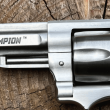



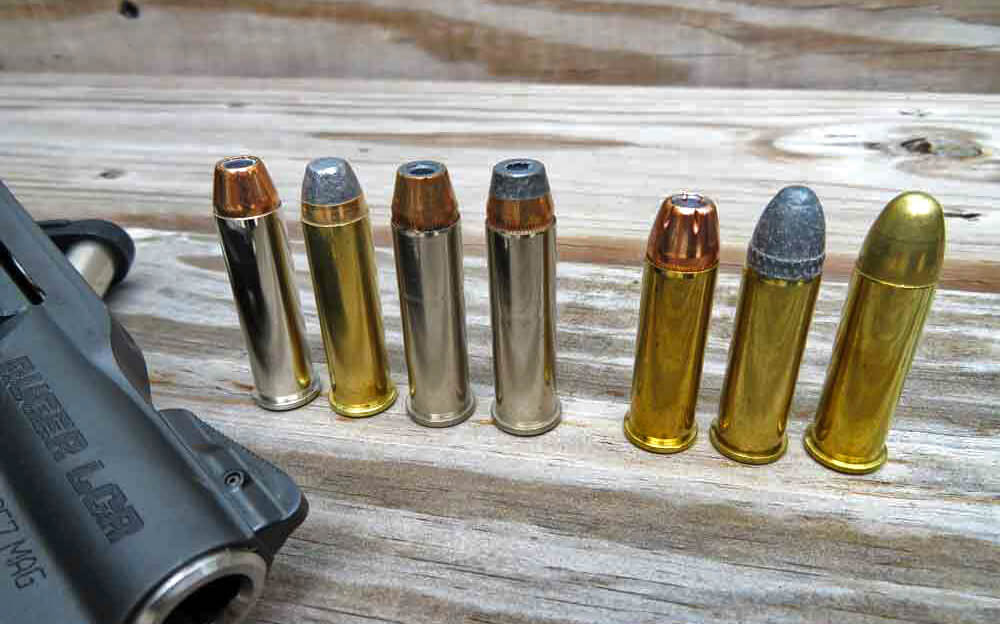
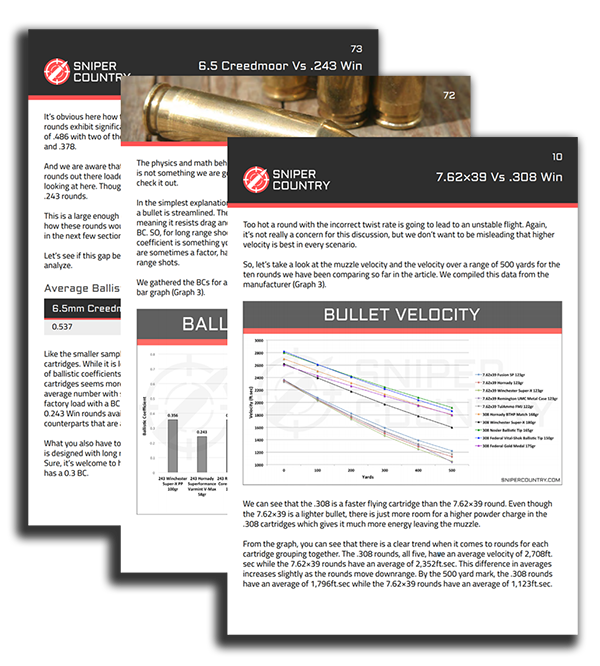

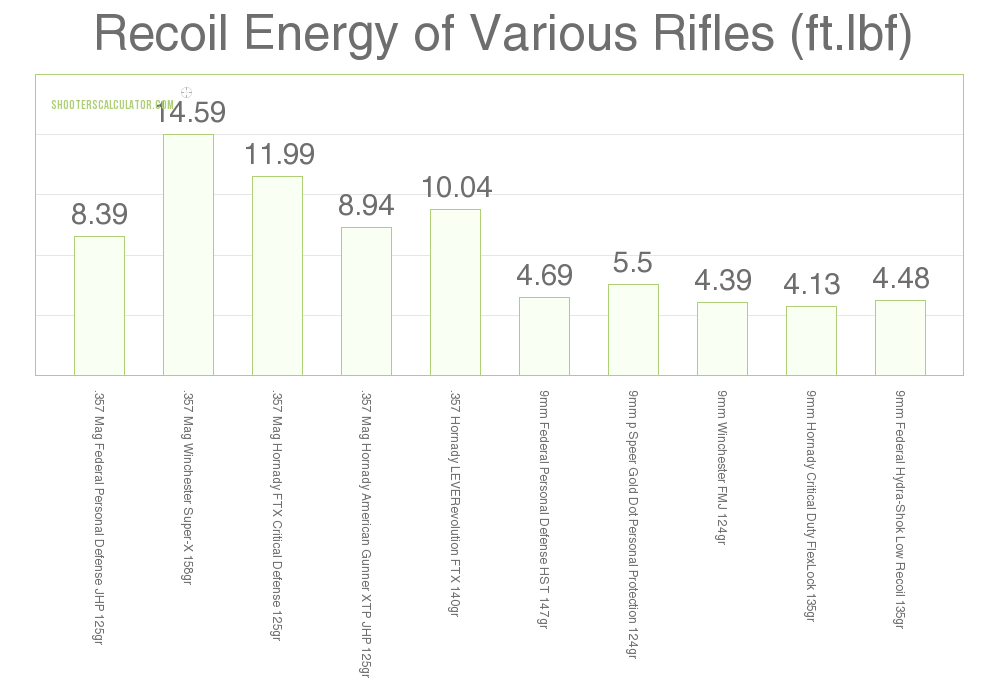
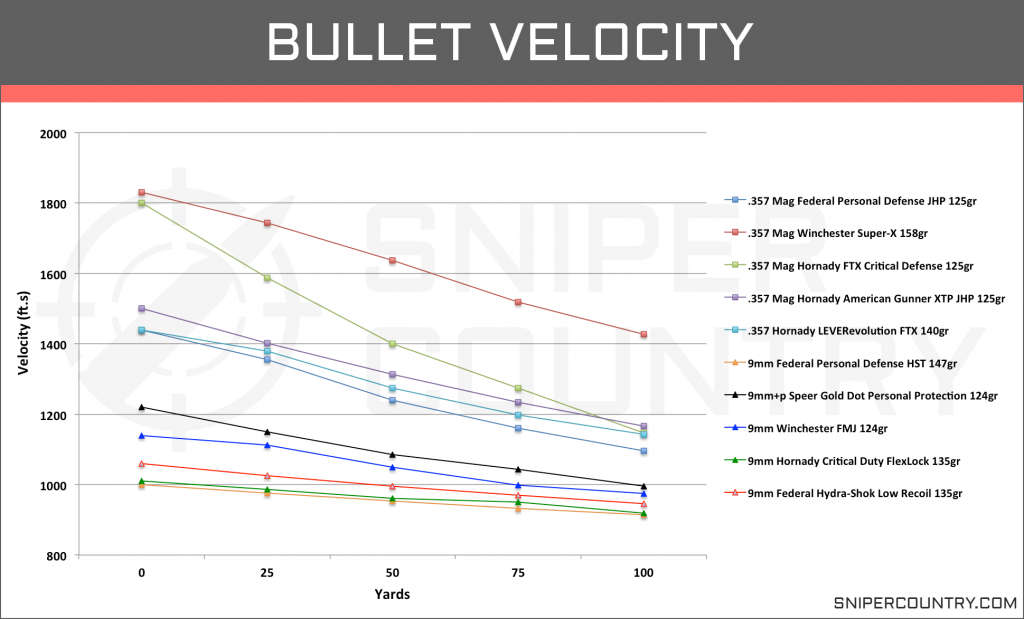
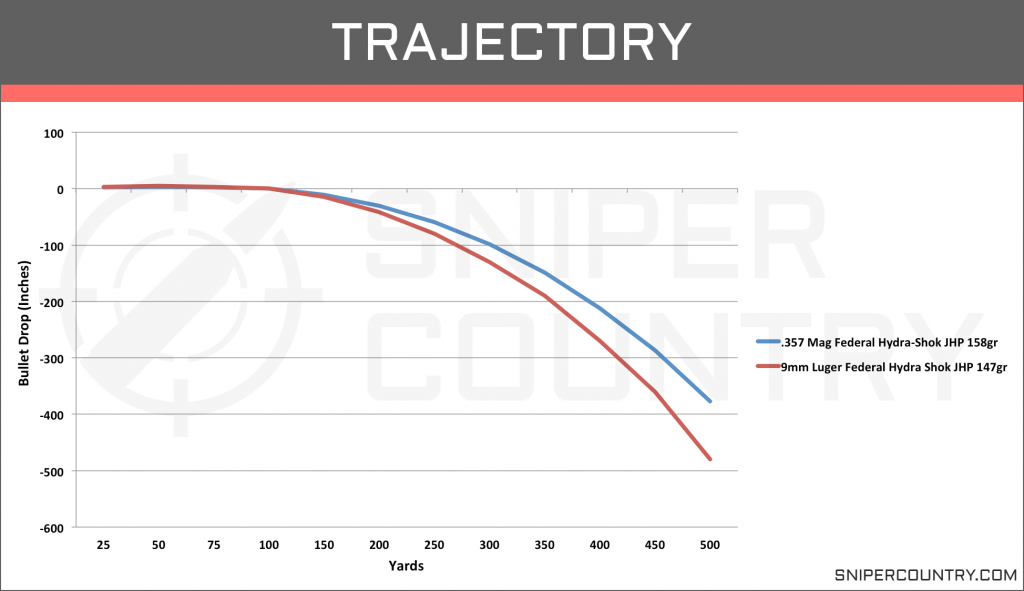
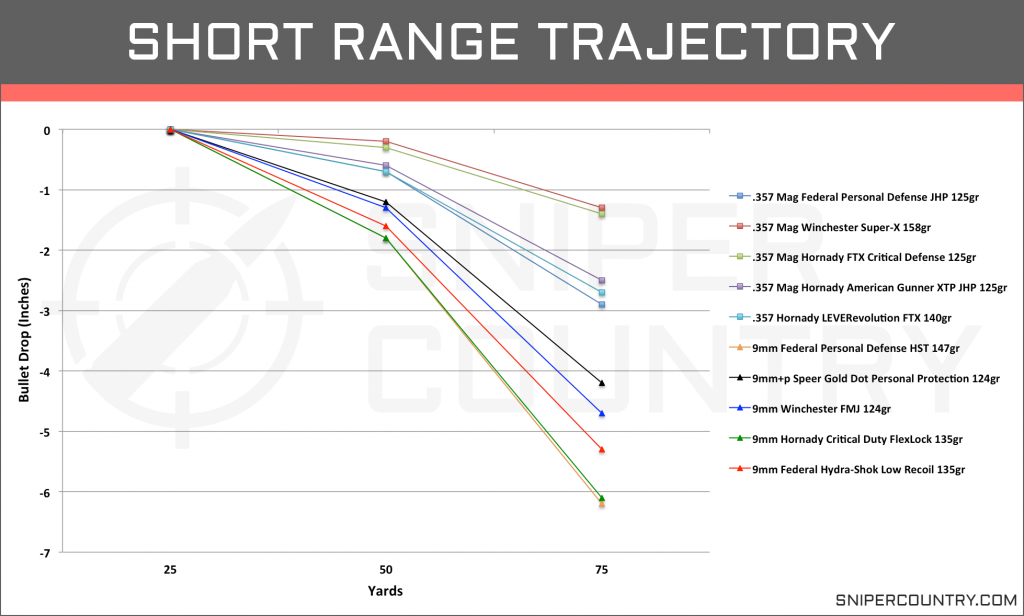
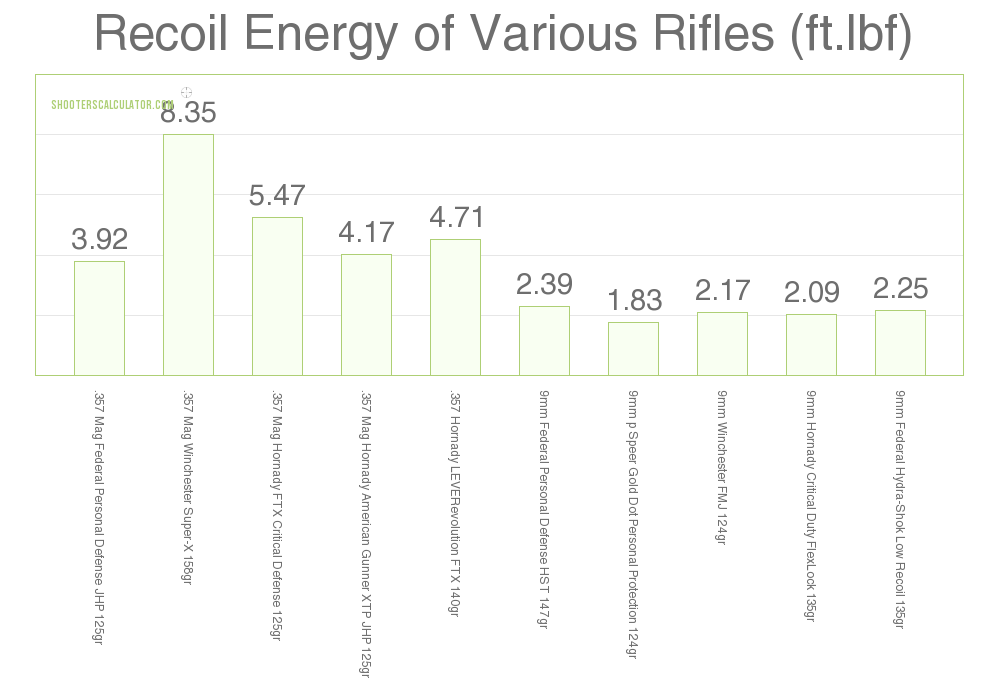
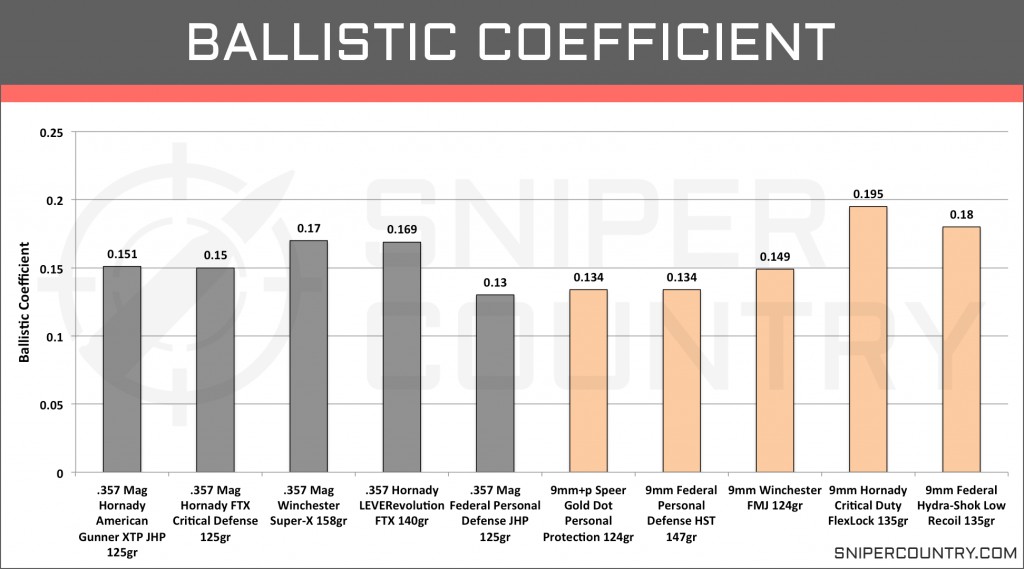
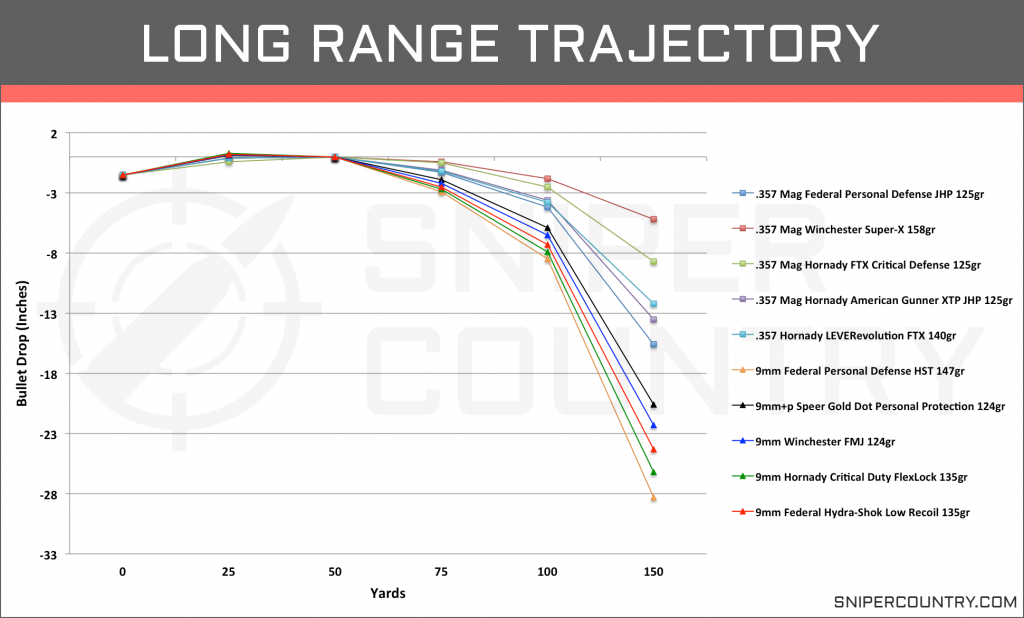
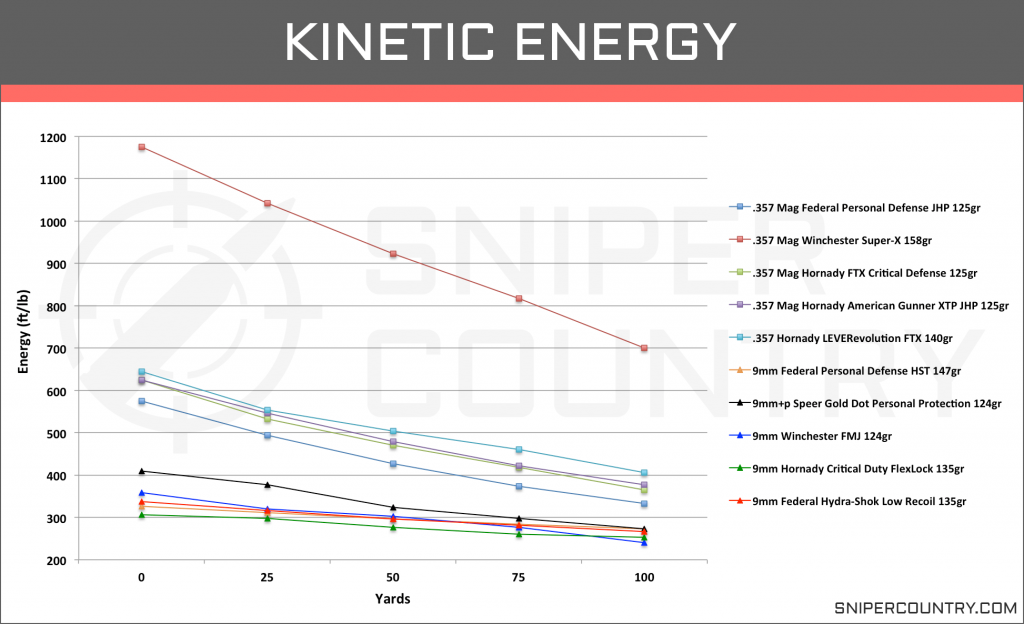
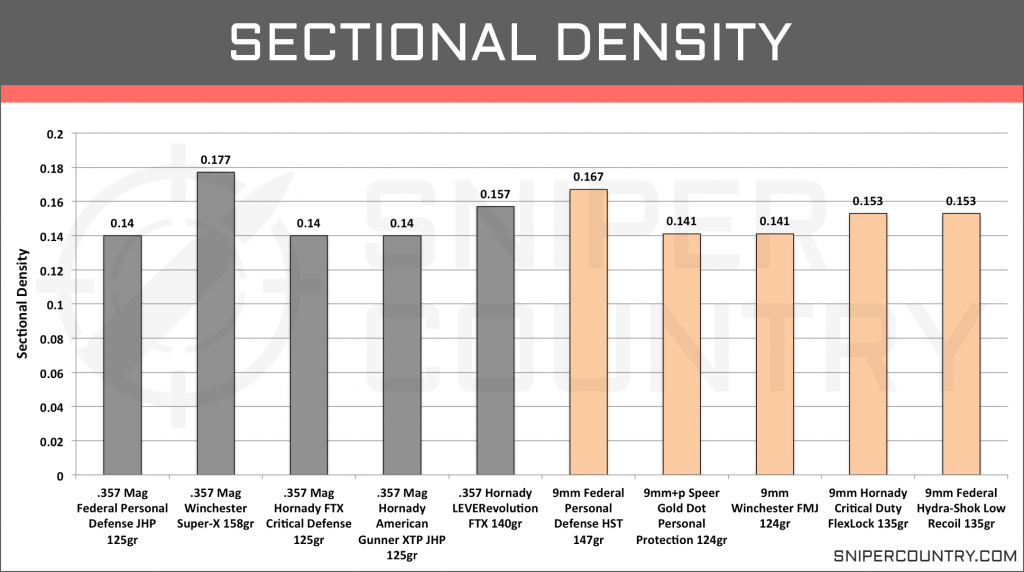
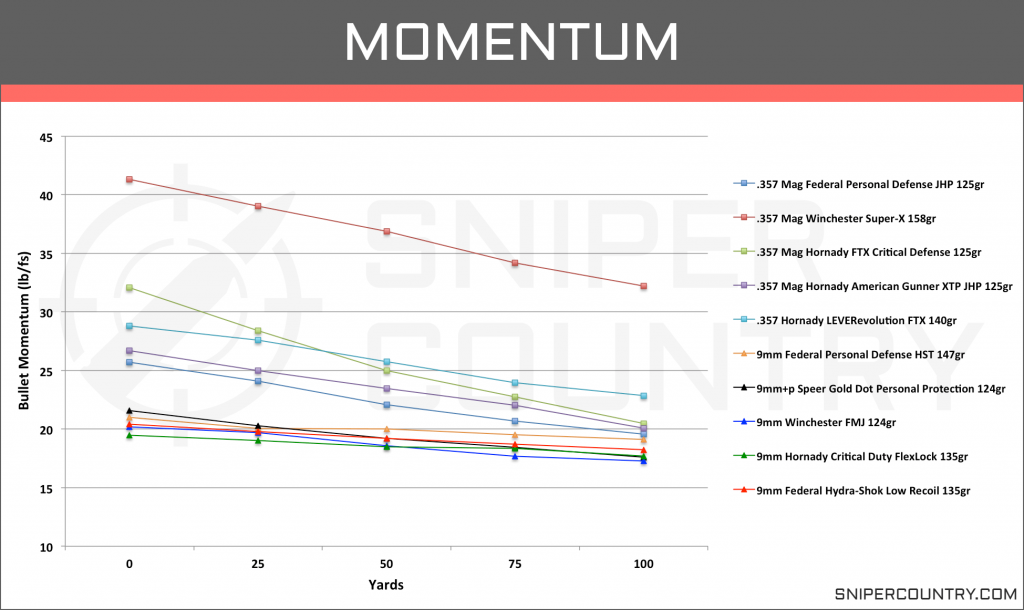

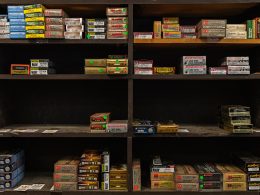
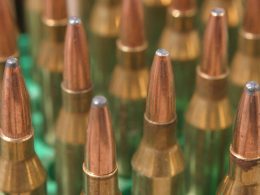
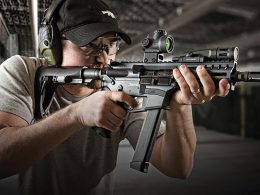
I am looking at various revolvers to purchase and this really offered a vast amount of information to consider when deciding between a 357 or 9. Thank you so much. Your research and comments have really helped in many ways—- WOW!!!!
spot on. I use a Ruger 77/357 carbine for hunting, and using the Hornady 140gn FTX, I can take ANY size deer that crosses my path. I try to limit my shots to a maximum of 150 – 200 yards using a Meopta Artemis scope zeroed at 100 yards. This has resulted in my always knowing where to aim to get the pill into the vital zone. I can honestly say that I have never needed to put another ” finishing” shot into any animal. The FTX is a very well designed round for hunting. It expands beautifully and creates an always fatal wound cavity. The great thing is, I can also use the FTX in my personal defence weapon and be assured of the desired stopping power.
Thoughtful, informed, unbiased review. I have a friend who jumps on to the latest trend in calibers and firearms. But often older calibers are still relevant and in some case superior to the latest thing. Thanks for your review.